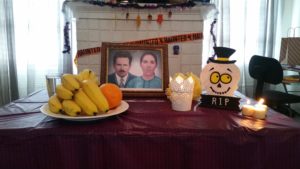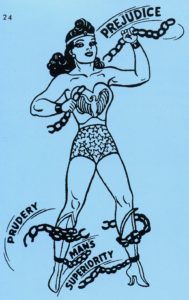
As el Dia de Los Muertos fast approaches, I can’t help but think of all the people who passed away in my family. Fortunately, I have not experienced the many deaths that have occurred in my family since I was not born yet when most of my family members passed away. Although I was not present at the time of my family members’ passing, my family and I still reminisce about the times when they were alive.
One family member that my family and I reminisce the most about is my grandmother on my mother’s side of the family who I never had the chance to meet. Even though I did not have the chance to meet my maternal grandmother, I still decided to dedicate my Dia de Los Muertos altar to her. The reason why I decided to dedicate my altar to my grandmother is not only because she’s family, but also because she was an admirable woman. My grandmother was a marvelous woman who has been painted as being this strong person who sacrificed a lot to take care of her family, despite the struggles she faced during her lifetime. In fact, my grandmother actually endured a tremendous amount of suffering before she married my grandfather, and even while she was married to my grandfather. Though there was love, loyalty, and trust between my grandparents, my grandmother did not end up having the blissful life she hoped to have after leaving an unhealthy family to marry my grandfather.
Growing up, my grandmother lived in poverty. Due to this poverty, her family forced her to work at such a young age. Because my grandmother was too young to take on the same types of jobs adults tend to have, my grandmother failed to bring home enough money, causing her to be scolded by her parents. For years, she endured emotional and mental abuse from her parents because she was seen as not a good enough to them. That is why, when my grandmother met my grandfather, she had hoped to marry him in order to leave her family and live a better life with him. However, although my grandfather loved her very much, she continued to live in poverty until her dying days while taking care of all her children on her own.
It is for this reason that my grandmother is such an admirable person. I look up to women like my grandmother, and even my mother, who was fortunate enough to have the same family values my grandmother had, who put their families first, no matter what, since family plays an important role in my life. Thus, I built this altar for my grandmother to convey the love and admiration I have for her, as well as to help her with her journey through the afterlife, in spite of the fact that I did not meet her in person.
Though I never got the chance to meet my grandmother in person, I have had the opportunity to get to know her through the family stories my mother has passed down to my siblings and I. Unfortunately, my mother was not able to “convivir” with her mother for too long since, sadly, my grandmother passed away when my mother was barely twelve years old. Nonetheless, my mother was still able to tell me fascinating stories about my grandmother that my mother was able to either hear, experience, or witness herself.
One story my mother told me as a child that I still remember till this day is the story of how my grandmother passed away. My grandmother died from complications after giving birth to her tenth child (my uncle). My mother told me that her mother, while married to her father, unfortunately, suffered two miscarriages that hurt physically and emotionally. In addition to the miscarriages she endured, my grandmother suffered the loss of a child, due to poison, as well. For this reason, my grandmother’s body was not strong enough when she gave birth to my uncle, which caused ended costing her life. Nevertheless, my mother told me that my grandmother passed away loving every single one of her children.
Aside from the story of how my grandmother died, there is another story, out of all the stories my mother has told me about my grandmother throughout the years, in particular that I will always remember. My mother once told me that one day, my grandmother was extremely worried about not being able to have food for the family since my grandfather, who was a farmer, was struggling to produce any money with the beans and vegetables he was growing at the time. So, that day, my grandmother started to pray to have something, anything, on the table to eat. A few hours later, a neighbor came by to see my grandmother, hoping to see if she had any extra textiles, since my grandmother sewed during her free time, that the neighbor could buy off of her to make a tablecloth. Recently, my grandmother had received some nice textiles as a gift from one of her friends, and she had initially planned to make her children clothes in time for the warm weather. However, because she needed the money to buy at least some “frijolitos y torillas,” she decided to sell her neighbor these textiles. My mother, then, told me that when my grandfather came home that day, he walked into the house with his head held down ready to give my grandmother the bad news that he did not end up making any money that day; but, to his surprise, he came home to food on the table and a look of relief came across his face.
I enjoy hearing stories of my grandmother because, even though she lived a stereotypical Latina life of being a stay-at-home wife and mother, she was by far a strong woman who did anything for her family. My grandmother, unfortunately, lived during a time where society was short-minded, and expected the woman to stay at home to take care of the home and children while the man went off to work. During this time, the Latino family, as Richard Rodriguez notes in his text, Next of Kin,was romanticized as being a heteropatriarchy in which “la familia” was comprised of a strong husband-father that supported the loving wife-mother who took care of their children. Rodriguez argues that “in this romanticized haven- a ’nation’ defined within the contours of domesticity-the archetypal [Latina] would necessarily provide a feminine spirit of maternal consolation (in spite of her suffering) while ensuring the procreation, hence survival, of [Latino] culture” (2). In other words, my grandmother was expected to support her husband and have lots of children despite her any suffering she endured by doing so. In addition, she had to keep up with society’s expectations by also having to cook, clean, and take care of her children while society allowed her husband to run the house, control his wife, and direct his children without taking into consideration the hard work a woman did for her family.
Regardless, though my grandmother had to play out the stereotypical Latina role of the stay-at-home wife and mother within the heteropatriarchy of “la familia,” through the stories my mother told me, I believe my grandmother was able to prove that women are far more stronger than men think. Although society tries to paint women as inferior to men within a heteropatriarchy family, women like my grandmother demonstrate that a woman’s job is not easy. Women sacrifice as much, if not more, than men do for their families, and that is exactly what my grandmother proved when she was still alive. Therefore, what my grandmother has proven is what I admire about her; it is precisely what empowers me as woman myself.
Before I move on to discussing how I structured my altar, I would like discuss how, despite not being Mexican, as a Guatemalan, I still appreciate Dia de Los Muertos because I like the idea of honoring the dead. Although I have come to learn that Dia de Los Muertos is celebrated in Guatemala, we don’t and have never celebrated this holiday in my family. Interestingly enough, I found out that Guatemala does celebrate Dia de Los Muertos, in spite of my belief that didn’t, except their version of the holiday differs in comparison to the way Mexicans celebrate it. In Guatemala, el Dia de los Muertos, or Dia de los Difuntos as they call it, is a celebration that marks the beginning of the holiday season for most Guatemalans. It is a three-day celebration that starts off the holiday season, which is then followed by La Quema del Diablo, Las Posadas, Noche Bueno, Navidad, and Año Nuevo. Similar to Mexico, on October 31st and November 1st, many Guatemalan families gather to honor their dead in family cemeteries; however, they do not tend to build altars for their dead loved ones. Then, on November 2nd, people tend to continue to honor the dead by flying giant kites overlooking the main cemetery in Sumpango, Guatemala. During this day, there is music, dancing, and food while kites are raised in the air for all to admire.
Nevertheless, regardless of the fact that Dia de Los Muertos is celebrated in my home country, my family does not partake in this holiday. Because of this, I admittedly had trouble constructing the altar for my grandmother. This is the reason wh my altar may not be big in scale nor has many details. Still, I made the altar in honor of my grandmother, and that is good enough for me.
When I built my altar, I covered a table with a purple tablecloth. I chose a purple because it’s the color of mourning. The only image my mom has of my grandma, is the image I placed in a gold-colored frame. Since yellow was her favorite color, I placed a bouquet of yellow carnations beside the photograph of my grandmother. I also placed yellow carnations in my altar because carnations symbolize health and energy, along with love, which is what I hope my grandmother feels wherever she is. Aside from that, I placed a sugar skull ornament in my altar as well to symbolize death since skulls represent death. I used white candles to light my grandmother’s path to the afterlife because white candles give off pure energy. The salt I placed in front of my grandmother’s photograph is used to help keep her from rotting as she journeys to the afterlife. The last things I then added to my altar was fruit and a cup of water to give as an “ofrenda” to my grandmother that she can feed off of during her journey to the afterlife as well.
My altar may not be as extravagant as the many altars people have built for their loved ones, but I know my grandmother appreciates and honors her, but it also pays respect to her. I may not have had the chance to meet the incredible woman, but I thank her for raising my mother to become the incredible woman my mother she has been to me. Maybe one day, I’ll get to meet my grandmother on the other side; for now, I will do my best to honor her until then.






